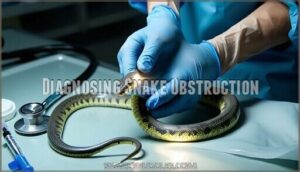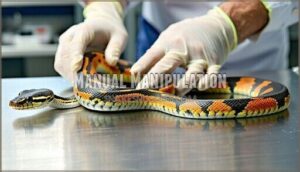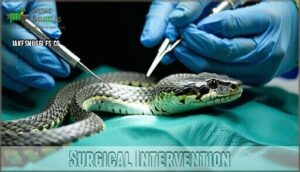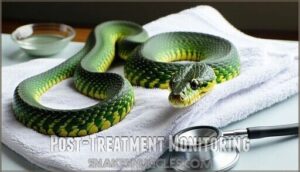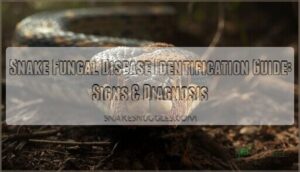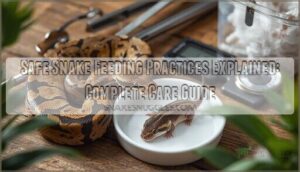This site is supported by our readers. We may earn a commission, at no cost to you, if you purchase through links.

This serious condition requires immediate veterinary attention – don’t attempt home remedies.
Common causes include ingesting substrate, oversized prey, or foreign objects.
Temperature issues and dehydration can worsen the problem.
Your exotic vet will likely perform radiographs or ultrasound to locate the blockage.
Treatment ranges from supportive care and manual manipulation to surgical removal, depending on severity.
Time is critical since obstructions can be life-threatening.
Prevention involves proper husbandry, appropriate prey sizing, and maintaining ideal temperatures.
Understanding the warning signs and risk factors can mean the difference between a quick recovery and a veterinary emergency.
Table Of Contents
- Key Takeaways
- Snake Obstruction Causes
- Recognizing Obstruction Symptoms
- Diagnosing Snake Obstruction
- Treating Snake Obstruction
- Preventing Future Obstructions
- Frequently Asked Questions (FAQs)
- How to help a snake with a blockage?
- How do you know if a snake has impaction?
- How to help a constipated reptile?
- How do you know if a snake is impacted?
- Why do snakes have blocked bowels?
- Are snakes constipated?
- What happens if a snake has an impaction?
- What are the symptoms of a snake blockage?
- How can I tell if my snake is impacted?
- Why does my snake sound congested?
- Conclusion
Key Takeaways
- Recognize the warning signs early – Watch for regurgitation, visible swelling, lethargy, and straining without defecation, as these symptoms indicate a serious condition requiring immediate veterinary attention.
- Don’t attempt home remedies – Avoid using oils, manual manipulation, or feeding when you suspect an obstruction, as these can worsen the condition and cause dangerous internal damage.
- Prevent obstructions through proper husbandry – Maintain correct temperatures, use appropriate prey sizing, choose safe substrates, and remove potential foreign objects from your snake’s enclosure.
- Establish veterinary care before emergencies – Build a relationship with an exotic veterinarian and schedule regular check-ups to catch problems early, as time is critical when obstructions occur.
Snake Obstruction Causes
Understanding what causes obstructions in your snake is essential for preventing serious health complications. Several factors can lead to dangerous blockages, from substrate ingestion to improper feeding practices.
Ingestion of Substrate
Substrate ingestion creates a dangerous digestive blockage when your snake accidentally swallows bedding material during feeding. Sand, gravel, and wood chips can’t be digested, leading to potentially fatal snake impaction.
Swallowing bedding like sand or wood chips can block your snake’s gut and quickly become life-threatening.
High-risk substrates to avoid:
- Sand and gravel (cause severe gut blockage)
- Cedar shavings (toxic and indigestible)
- Small rocks or pebbles (create intestinal blocks)
Feeding hazards increase when prey items contact loose substrate. Your snake’s digestive system can’t process these materials, causing snake digestive problems that require immediate veterinary attention. It’s vital to understand the risks of substrate swallowing to take preventive measures and safeguard your snake’s health.
Improper Prey Items
Feeding Errors create serious complications when you offer inappropriate Prey Size or Food Types.
Oversized prey items that exceed your snake’s girth by more than 20% can cause snake impaction, while frozen prey that’s inadequately thawed creates digestive problems.
These Feeding Issues disrupt normal Digestion Issues, leading to snake intestinal block.
| Prey Problem | Risk Level |
|---|---|
| Oversized meals | High impaction risk |
| Poorly thawed food | Moderate blockage risk |
| Multiple prey items | Severe obstruction potential |
Foreign Objects Ingestion
Your snake might swallow cage decorations, bedding materials, or loose substrate during feeding excitement.
These foreign objects create dangerous digestive blockages requiring immediate veterinary attention.
- Plastic plants – Artificial decorations can break into sharp fragments
- Loose substrate – Wood chips, gravel, or sand accumulate in the gut
- Water bowl accessories – Thermometers or decorative items become ingested items
- Shed skin pieces – Old skin can cause bowel obstruction if consumed
Snake surgery for object removal becomes necessary when foreign body ingestion creates complete digestive blockage.
This snake health issue requires professional intervention to prevent serious complications.
Dehydration Effects
When your snake doesn’t get enough water, things go downhill fast.
Fluid loss slows digestion dramatically, turning normal food passage into a sluggish crawl that creates snake digestive blockage. Dehydration signs include wrinkled skin and sunken eyes.
Poor water intake disrupts electrolyte balance, making snake constipation worse.
Hydration therapy becomes critical for treating this snake health issue.
Temperature Gradient Issues
Temperature management directly impacts your snake’s digestive health and prevents dangerous obstructions.
Poor thermal gradients in your pet’s enclosure create the perfect storm for snake digestive blockage complications.
- Heat Sources: Position primary heating elements to create distinct warm and cool zones
- Thermal Gradients: Maintain 10-15°F difference between basking and cool areas
- Temperature Control: Use reliable thermostats to prevent dangerous fluctuations
- Climate Management: Monitor both surface and ambient temperatures consistently
Inadequate enclosure design disrupts normal digestion, leading to snake constipation and potentially life-threatening snake intestine blocks.
Recognizing Obstruction Symptoms
Spotting obstruction symptoms early can save your snake‘s life and prevent serious complications. Watch for these telltale signs that indicate your pet needs immediate veterinary attention.
Regurgitation Signs
Regurgitation ranks as the top warning sign in over 80% of snake obstruction cases.
When your pet snake brings up undigested food repeatedly, it’s often signaling digestive problems beyond normal feeding issues.
This vomiting causes immediate concern since healthy snakes rarely regurgitate.
Watch for timing patterns – obstruction-related regurgitation symptoms typically occur within hours of eating, unlike stress-related incidents that happen days later, indicating a potential obstruction.
Visible Swelling
Beyond simple regurgitation, you’ll notice obvious physical changes when your snake has an obstruction.
Look for swollen scales or an abdominal mass that creates visible body deformation along your pet’s torso. This snake obstruction often appears as a distinct bulge that wasn’t there before.
Check for skin lesions or tissue damage around the affected area, as these indicate a serious snake medical emergency requiring immediate veterinary attention for your pet snake care needs.
It’s vital to monitor for skin infection symptoms to prevent further complications in your pet snake, which can lead to a pet snake care crisis and require immediate veterinary attention.
Lethargy and Reduced Activity
When your pet snake develops an obstruction, you’ll notice dramatic shifts in their normal routine.
Lethargy signs become obvious as your snake’s energy loss affects daily behaviors, and reduced mobility replaces their usual exploration patterns.
Snake behavior changes from active to sluggish, signaling a potential snake medical emergency, often accompanied by other snake feeding issues.
This reptile health problem makes activity levels a key diagnostic indicator.
Straining Without Defecation
When your snake attempts to defecate but can’t produce results, you’re witnessing a classic sign of bowel blockage. This snake straining behavior indicates digestive problems where stool retention prevents normal waste elimination.
Pet snake obstruction creates visible distress as your reptile pushes without success.
- Watch for repeated positioning attempts in the defecation posture without producing waste
- Notice increased time spent in one area trying to eliminate stool
- Observe visible abdominal contractions or pushing motions that yield no results
- Check for small amounts of mucus or blood without solid waste passage
- Monitor frequency of unsuccessful elimination attempts throughout the day to identify potential issues with your snake’s health, including signs of abdominal contractions or other related problems.
Weight Loss and Dehydration
When obstruction progresses, you’ll notice your snake losing weight despite normal feeding schedules.
This gradual decline signals your pet’s body isn’t processing nutrients properly. Dehydration compounds the problem, creating a dangerous cycle requiring immediate veterinary intervention and fluid therapy.
| Dehydration Signs | Weight Management | Snake Nutrition |
|---|---|---|
| Sunken eyes | Weekly weigh-ins | Proper prey sizing |
| Skin tenting | Body condition scoring | Feeding schedules |
| Lethargy | Growth rate monitoring | Hydration tips |
| Reduced urination | Appetite tracking | Veterinary consultation |
Diagnosing Snake Obstruction
When you suspect your snake has an obstruction, getting an accurate diagnosis is essential for proper treatment.
Your veterinarian will use several diagnostic tools to confirm the blockage’s location and severity, helping determine the best course of action for your pet’s recovery.
Radiography Diagnosis
X-ray imaging serves as your first diagnostic tool when veterinary advice suggests reptile blockage.
Radiograph results reveal radiopaque foreign objects clearly, while contrast studies using barium help identify radiolucent obstructions that plain films miss.
Medical imaging requires multiple views for accurate localization, and these diagnostic techniques detect segmental intestinal dilation—the telltale sign of snake eating issues requiring immediate attention.
Understanding foreign body issues is essential for effective treatment and prevention of reptile obstructions, which involves recognizing the importance of immediate attention to certain conditions.
Ultrasound Evaluation
While X-rays reveal solid obstructions, ultrasound imaging provides detailed views of soft tissues and fluid-filled blockages in your snake’s digestive tract.
This diagnostic tool helps veterinarians assess organ damage and blood flow around the obstruction site.
Veterinary guidance guarantees proper ultrasound technique for accurate snake anatomy evaluation.
Medical imaging like ultrasound offers real-time visualization, making it invaluable for reptile blockage diagnosis and treatment planning.
Contrast Studies
When ultrasound doesn’t provide clear answers, your vet might recommend contrast studies.
These diagnostic tools use contrast agents like barium sulfate to highlight your snake’s digestive tract during medical imaging.
Radiology procedures with these imaging techniques create detailed pictures, showing exactly where blockages occur.
This snake veterinary help combines deep learning technology with traditional diagnostic methods, giving your reptile care specialist the clearest view possible for accurate treatment decisions.
Bloodwork Analysis
Laboratory analysis reveals critical information about your snake’s internal condition.
Bloodwork helps veterinarians assess organ function, hydration status, and potential complications from obstruction.
Here’s what bloodwork typically includes:
- Hematology – Complete blood count checking for infection or anemia
- Biochemistry – Liver and kidney function markers indicating organ stress
- Electrolyte Tests – Sodium, potassium, and chloride levels affected by dehydration
- Blood Gas – Acid-base balance disrupted by prolonged obstruction
- Toxicology – Screening for substrate or foreign material toxicity when indicated.
These tests guide treatment decisions and help veterinarians provide targeted snake veterinary help for your reptile’s recovery.
Physical Examination
Your vet’s hands become detective tools during palpation techniques, feeling along your snake’s body for unusual bumps or hardened areas.
Visual inspection checks for swelling while abdominal examination reveals abnormal distention.
They’ll assess muscle tone and body condition to gauge overall health. This hands-on approach, combined with snake care advice, helps pinpoint obstruction location before determining treatment options.
Regular monitoring of snake health, including awareness of common snake illnesses, is essential for early detection and effective treatment.
Treating Snake Obstruction
When your snake develops an obstruction, immediate veterinary care becomes critical for successful treatment outcomes. The treatment approach depends on the obstruction’s severity, location, and your snake’s overall health status.
Supportive Care
Once your vet confirms the obstruction, immediate supportive care becomes your snake’s lifeline.
This thorough approach stabilizes your pet while preparing for potential intervention.
- Fluid Therapy – IV or subcutaneous fluids combat dehydration and maintain electrolyte balance
- Pain Management – Analgesics reduce discomfort and stress during treatment
- Nutritional Support – Assisted feeding may be necessary for extended recovery periods
- Hospitalization – 24/7 monitoring guarantees rapid response to complications
- Environmental Control – Ideal temperature and humidity promote healing
Effective snake care involves understanding fluid therapy options to address dehydration.
Manual Manipulation
While supportive care stabilizes your snake, gentle technique can address minor obstructions without invasive procedures.
Manual removal involves carefully palpating the blockage and using controlled pressure to encourage movement through the digestive tract.
This snake handling approach requires veterinary guidance to avoid injury.
Proper manual manipulation techniques can provide obstruction relief when performed correctly, making it valuable snake care advice for reptile enthusiasts seeking effective treatment options.
Surgical Intervention
When manual manipulation fails, surgery becomes your snake’s lifeline.
Veterinary specialists use surgical tools to perform coeliotomy, making precise incisions between lateral scales.
Anesthesia use requires careful monitoring due to surgery risks in reptiles.
Your vet’s guidance guarantees proper technique and post-operative care.
Recovery time varies, but most snakes heal within weeks with proper reptile care tips and snake care advice.
Lubricant or Enema Use
Lubricant types like mineral oil aren’t recommended for snakes—they can cause aspiration pneumonia.
Enema solutions require veterinary supervision since administration risks include internal injury and stress.
Home remedies often backfire, unlike hockey training where you control the strategy.
Addressing the issue might require identifying causes of snake impaction.
Professional reptile care tips emphasize that improper lubricant use creates more problems than solutions for your snake’s health and that understanding the causes is crucial.
Post-Treatment Monitoring
Once your snake’s obstruction resolves, careful monitoring becomes your lifeline to full recovery.
Track these key indicators to confirm your pet bounces back safely:
- Feeding Reintroduction: Start with smaller prey items and monitor digestion carefully
- Behavior Changes: Watch for normal activity levels and appetite return patterns
- Hydration Levels: Verify adequate water intake and assess skin elasticity regularly
Monitor wound care sites, follow medication schedules precisely, and document performance metrics for your vet’s performance analysis.
Preventing Future Obstructions
Once you’ve successfully treated your snake’s obstruction, preventing future episodes becomes your top priority.
The key lies in creating ideal husbandry conditions and maintaining consistent monitoring practices that address the root causes before they become life-threatening emergencies, which involves consistent monitoring.
Proper Temperature Regulation
Maintaining consistent temperature regulation prevents digestive slowdowns that commonly trigger snake obstruction.
Your thermostat accuracy matters—a two-degree variance can spell trouble for your pet’s health.
Install heating pad safety features and monitor basking spot temp daily.
Infrared lamps provide gentle warmth without hot spots.
Make seasonal adjustments as your home’s ambient temperature changes throughout the year, and ensure to maintain a consistent temperature to prevent digestive slowdowns.
Balanced Diet and Nutrition
Feeding your snake properly prevents many obstruction cases. A balanced approach to nutrition directly impacts digestive health and reduces blockage risks.
Key Nutrient Requirements for Obstruction Prevention:
- Whole prey items provide complete protein profiles and prevent nutritional gaps
- Appropriate prey size matches your snake’s girth to avoid impaction issues
- Regular feeding frequency maintains healthy digestion without overloading the system
- Prey variety guarantees thorough mineral and vitamin intake
- Pre-killed options eliminate injury risks and maintain consistent nutritional value
Proper supplementation needs vary by species, but whole prey typically covers most requirements. Consider snake’s whole prey for peak nutrition.
Monitor feeding frequency to prevent obesity, which slows digestion and increases obstruction risk. Like athletic performance in hockey nutrition where team performance depends on balanced intake, your snake’s digestive system relies on consistent, appropriate nutrition. Sports analytics show that ideal athletic insights come from proper fuel – the same principle applies to snake health through strategic prey selection and timing.
Adequate Hydration
Water intake directly impacts your snake’s digestive system and obstruction risk.
Provide fresh water in a bowl large enough for soaking, as many species drink while bathing.
Monitor humidity levels between 50-60% for most species, adjusting misting frequency accordingly. Optimal hydration helps maintain healthy scales.
Watch for dehydration signs like wrinkled skin or sunken eyes, which slow digestion and increase impaction risk.
Avoiding Foreign Objects
Remove cage decorations that could break or chip into bite-sized pieces.
Secure enclosure furniture with non-toxic adhesives to prevent movement during feeding time.
Choose safe substrates like paper towels instead of loose materials.
Inspect your snake’s habitat weekly for damaged items that might become foreign objects.
Consider purchasing specialized reptile products for safer enclosures.
Object awareness prevents costly veterinary emergencies, which is crucial for the snake’s health and safety.
Regular Veterinary Check-Ups
Routine examinations serve as your first line of defense against hidden health issues.
Veterinary professionals can detect early warning signs before they become serious problems.
- Early Detection through thorough physical examinations every 6-12 months
- Preventative Care including parasite screening and nutritional assessments
- Health Monitoring with baseline measurements for weight and body condition
- Expert Advice on proper husbandry practices and environmental setup
- Cost Savings by addressing minor issues before they require emergency intervention
Frequently Asked Questions (FAQs)
How to help a snake with a blockage?
Gastrointestinal blockages don’t always require surgery—many resolve with proper veterinary care.
Contact your reptile veterinarian immediately for diagnostic imaging and treatment.
Don’t attempt home remedies like manipulation or feeding, as these can worsen the condition and cause serious internal damage.
How do you know if a snake has impaction?
You’ll spot visible swelling or a hard lump along your snake’s body, plus they’ll refuse food, regurgitate, strain without passing waste, become lethargic, and may lose weight noticeably.
How to help a constipated reptile?
Overwhelmingly frustrated reptiles need immediate veterinary attention for proper diagnosis.
You’ll want to increase humidity, provide warm soaks, and make certain of proper temperatures.
Don’t attempt home remedies like oils or manual manipulation – these can worsen the condition dangerously.
How do you know if a snake is impacted?
You’ll notice visible swelling or a palpable mass along your snake’s body, regurgitation, refusal to eat, lethargy, and straining without passing waste. These signs indicate potential impaction requiring veterinary attention.
Why do snakes have blocked bowels?
Blocked bowels happen when your snake’s digestive system becomes impossibly clogged with substrate, oversized prey, or foreign objects, compounded by dehydration and inadequate temperatures slowing gut motility.
Are snakes constipated?
Snakes aren’t truly constipated like mammals. They experience obstructions or impactions when food, substrate, or foreign objects block their digestive tract, preventing normal bowel movements and requiring veterinary intervention.
What happens if a snake has an impaction?
Impactions affect over 80% of snakes with obstructions, causing regurgitation, visible swelling, and lethargy.
You’ll notice straining without defecation, weight loss, and dehydration.
Early intervention yields favorable outcomes in 80% of cases requiring supportive care or surgery.
What are the symptoms of a snake blockage?
You’ll observe regurgitation or appetite loss, visible swelling along the body, lethargy, straining without defecation, and weight loss in affected snakes requiring immediate veterinary attention.
How can I tell if my snake is impacted?
Look for visible swelling or lumps along your snake’s body, watch for refusal to eat or regurgitation, and check for straining without defecation. These signs indicate potential blockage.
Why does my snake sound congested?
Respiratory distress in snakes often indicates upper respiratory infections caused by bacteria, viruses, or environmental stress.
You’ll hear wheezing, mouth breathing, or gurgling sounds.
Poor humidity, temperature fluctuations, or substrate irritants commonly trigger these infections requiring immediate veterinary attention.
Conclusion
Recognizing when "my snake has an obstruction" enables swift intervention that can save your pet’s life.
Early detection through visual inspection and behavioral monitoring provides the foundation for successful treatment outcomes.
While veterinary care remains essential, understanding prevention strategies empowers you to maintain ideal husbandry conditions.
Temperature regulation, proper prey sizing, and substrate selection directly impact your snake’s digestive health.
Monitor your snake regularly and establish a relationship with an exotic veterinarian before emergencies arise, ensuring you can provide the best possible care for your pet’s overall well-being.
- https://www.wahahockey.com/
- https://www.vetlexicon.com/exotis/reptiles/gastrohepatology/articles/gastrointestinal-obstruction/
- https://www.reddit.com/r/cornsnakes/comments/1f7v99v/is_this_substrate_okay_if_she_accidentally/
- https://www.redtailboas.com/forum/boa-general-care-husbandry/feeding-issues/5646-swallowing-substrate
- http://library.iucn-isg.org/documents/2013/Banzato_2013_Veterinary_Record.pdf






